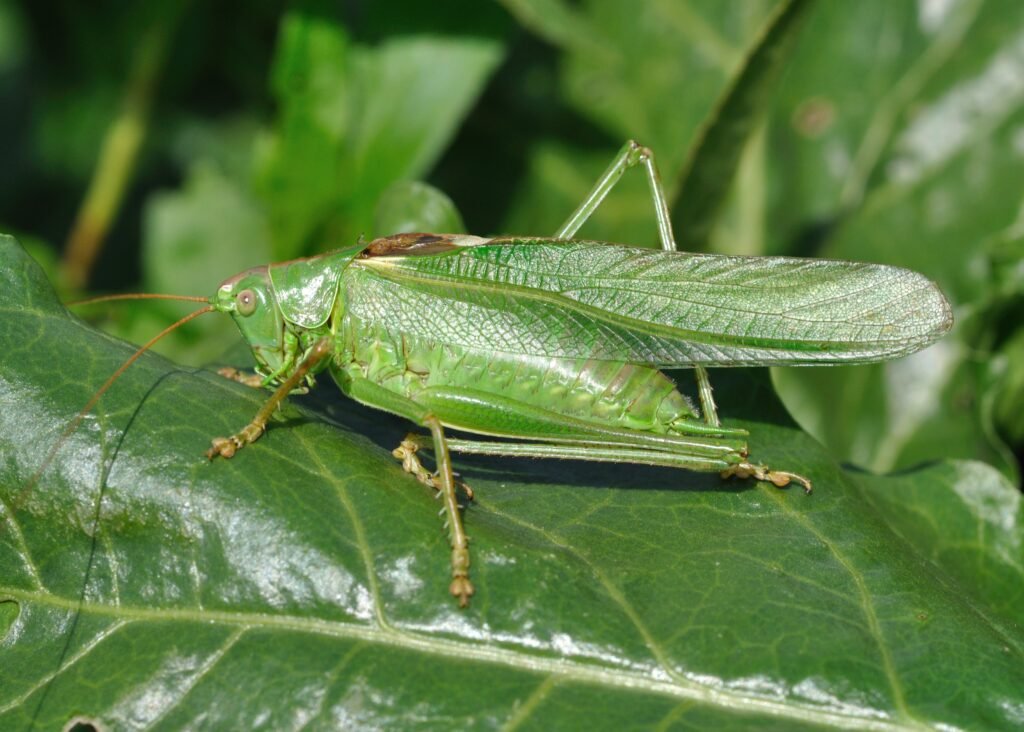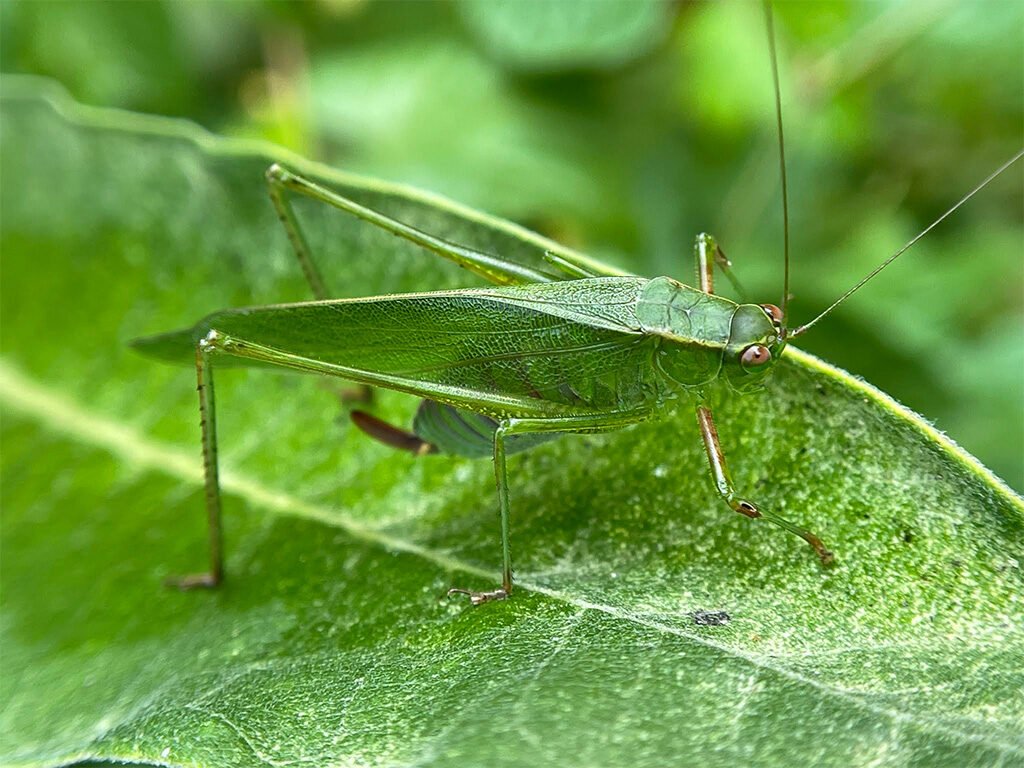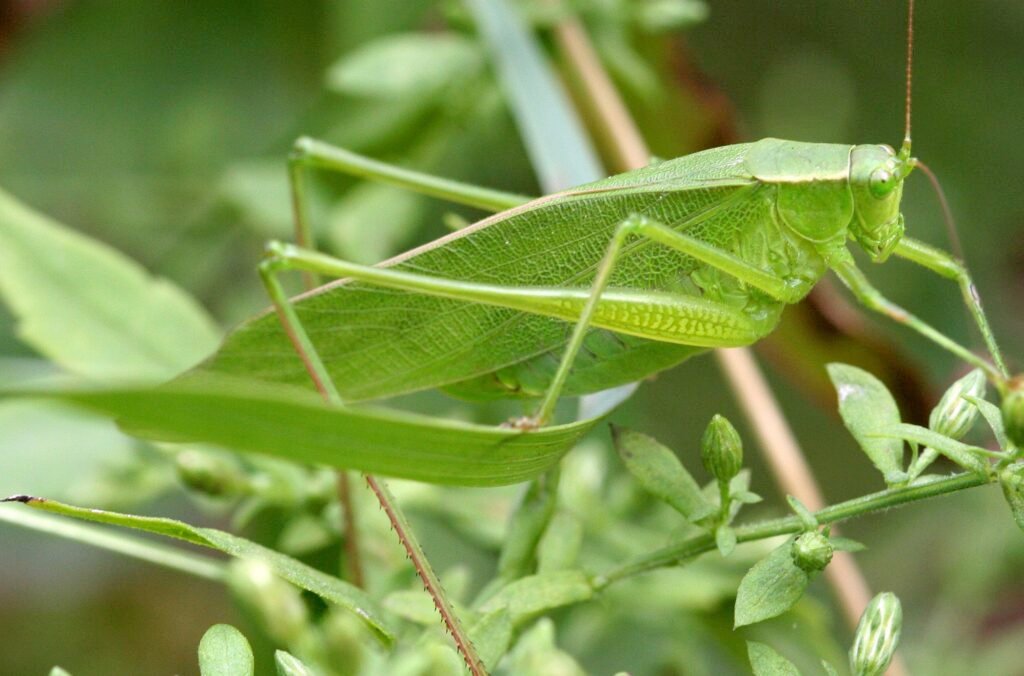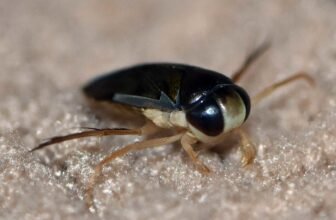
Katydid insects are a type of cricket-like insect in the family Tettigoniidae, which is a small group within the orthopteran order. Famous for their melodic calls and extraordinary mimicry of leaves, katydids are a marvel to behold in nature’s design. From the diverse habitation of where they dwell to how they act, adapt and interact with their eco-system.
In this full blog, we will discuss the fascinating family of katydids and include physical features, habitat, lifecycle, diet, distinctive features and their necessity to the atmosphere.
Table of Contents
Physical Features of Katydid Insects
Katydids are known for their long, thin bodies, bright green color and wings that look like leaves. These wings have a purpose beyond camouflaging; they are used for communication.
Key Features:
- Size: Depending on the species, katydids can be 1 to 4 inches long.
- Coloration: The most common species are green, imitating leaves; others have brown or pink variants for particular settings.
- Antennae: Its antennae are extremely long, sometimes more than twice the length of its body, and it uses them to sense its environment.
- Wings: The wings are veined and textured to resemble foliage, making them extremely cryptic when predators are near.
- Legs: Katydids use their long hind legs for jumping and to avoid threats.

Habitat and Distribution of Katydid Insects
Katydids are found everywhere, living in tropical and temperate regions all over the world. Their populations peak in rainforests, where there is more food and cover available due to dense vegetation.
Preferred Habitats:
- Forests and woodlands
- Grasslands
- Shrublands
- Urban gardens
Katydids are arboreal, generally living in trees and bushes; some species dwell closer to the ground. They are naturally camouflaged and stay out of sight of predators such as birds, reptiles, and mammals.

Lifecycle of Katydids
This lifecycle allows Katydids to be an extremely adaptable and skillful survivor. Like other insects, there is an incomplete metamorphosis with egg, nymph and adult stages.
Stages of Development:
- Egg Stage: Female katydids deposit eggs on leaves, stems or the soil. Eggs are small and can take several weeks to months to hatch, depending on environmental conditions.
- Nymph Stage: Nymphs look like tiny adults, but without full wings. They go through multiple molts, getting bigger each time until they are fully grown.
- Adult Stage: When they mature, katydids grow wings and genitalia. They live for a few months, mainly to feed and reproduce.
Diet and Feeding Habits of Katydid Insects
Katydids are generally herbivores, consuming foliage, flowers, fruits, and stems of plants. But certain species are omnivores, dining on small insects and other arthropods.
- Dietary Highlights:
- Herbivorous Species: They depend on plants for food, and many aid in pollination and seed dispersal.
- Omnivorous species: These katydids also eat protein-enriched prey, which helps keep pest populations in check.
- They can also cause occasional damage to crops and vegetables and therefore act as pests to farmers and gardeners on occasion.

Unique Traits and Behaviors of Katydid Insects
- Updates: • Katydids, also known as bush crickets, belong to a distinct family of insects with unique traits and behaviors.
- Camouflage Experts: Katydids’ leaf-shaped bodies are a classic example of mimicry. That way, they can blend into their surroundings and avoid predators.
- Acoustic Communication: Katydids are also among the most sound-producing insects. Males produce rhythmic calls by rubbing their forewings together—a process called stridulation. There are two functions at play in these calls:
- Attracting mates.
- Establishing territory.
Each species has its own unique song, enabling identification by their calls.
- Nocturnal Lifestyle: Katydids are nocturnal, using the cover of darkness to protect themselves from predators. They are virtually invisible due to their green color and nocturnal habits.
- Katydids are ecologically important.
Katydid Insects help keep ecological balance.
- As Prey: Katydids are a vital source of food for birds, bats and other predatory animals, so they play an important role in the food chain.
- As Pollinators: As they feed on flowers, katydids help with pollination as an indirect way to reproduce plants.
- In Pest Control: Omnivorous species are important for keeping populations of harmful insects in check, which is useful to agricultural systems.

The Sightings: Humans and Katydids
For centuries, katydids have inspired humans. Their songs are associated with peaceful nights and find mention in folklore and literature. But their nature with humans isn’t always harmonious.
Benefits to Humans:
- Their beauty adds aesthetics to nature.
- Ombivorous katydids are helpful to get pest populations under control.
Challenges:
- Crop Damage: These plant-eating insects are known to strip leaves off of the plants that they infest, which can interrupt agricultural production.
Interesting Facts About Katydid Insects
- Varied Songs: Different species produce distinctive calls that can travel great distances.
- Mimicry Beyond Leaves: Some katydids imitate flowers or sticks, demonstrating a range of camouflage strategies.
- Global Diversity: There are more than 6,000 species of katydid around the world, and many still remain undiscovered.
- Sensitive Ears: Katydids have tympanal organs (ears) on their front legs, so they can sense sound waves, including the movements of predators.
- Surprising Relatives: They may look dainty, but katydids are close relatives of crickets and grasshoppers.
- Conservation Status: Although most species are abundant, habitat loss and climate change pose threats to katydids. It’s critical to preserve forests and grasslands for their survival.”
Steps for Conservation of Katydid Insects:
- Supporting afforestation and reforestation efforts.
- Use fewer pesticides on their flowers to protect their habitats.
- Raising consciousness their ecological role.
FAQs about Katydid Insects:
Q1. What do Katydid insects eat?
A1. Katydids are mostly plant eaters and consume leaves, flowers, fruits, and stems. Some are even omnivorous, consuming small insects.
Q2. Where are katydid insects found?
A2. Katydids are common in forests, grasslands, shrublands and urban gardens; their greatest diversity is found in tropical areas.




